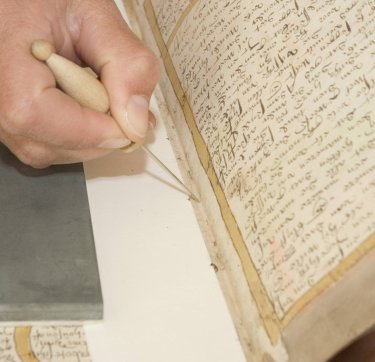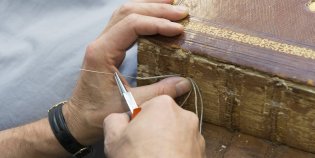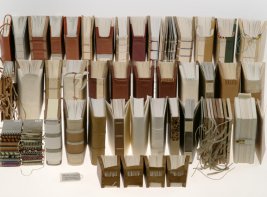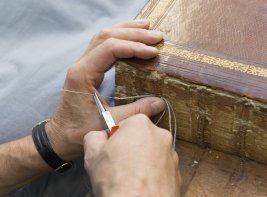Restoration: KB expertise
We can restore books that are damaged and likely to deteriorate with further use. This sometimes means that the appearance or structure of the book changes. Making a new spine is a good example. We try to restore as little as possible in order to maintain the book’s authenticity.
How does restoration work?
Most of the books we restore come from the KB’s Special Collections. In the past, we simply re-bound the books, but we don’t do this anymore. We try to restore as little as possible. We do this out of respect for the material, the maker and past users or owners. We want our books to show signs of their history.
The restorer studies the book very carefully before deciding how to approach the restoration. They want to know all about the book, how it was made, what it has been through. The restorers keep a record of everything they do. They take photos or make drawings if necessary so that we will always know what has been done to the book.
Why is restoration so important?
It is important to ensure that collections remain accessible and usable, both now and in the future. This includes the most fragile books. Restoration can ensure that a damaged book can be put on display and read again. Books that are damaged beyond repair can often be digitised instead, ensuring that they continue to be accessible to a large group of people.
A few examples of restoration
Renewing the spine is a good example of our restoration work. This involves replacing the old spine with a new one. We use traditional techniques. In the case of a leather spine, we try to find leather that closely resembles the original material. We then cut the leather to size before dyeing and skiving it (making the leather thinner with a knife), so that the edges of the new leather merge neatly with the old leather. This is a time-consuming, meticulous job. If we have any fragments of the original spine, we attach them to the new spine.
Some restorations don’t take quite this long. Take fixing the head and tail of the spine, for example. These are the edges at the top and bottom of the spine. Repairing corners and fixing loose pages is also a fast job.
Our experts in the area of book restoration
- Imke Neels, book restorer
- Paulien Rings, book restorer
- Ilse Korthagen, book restorer
- Nicole van der Sterren, conservation advisor (digitalisation)




